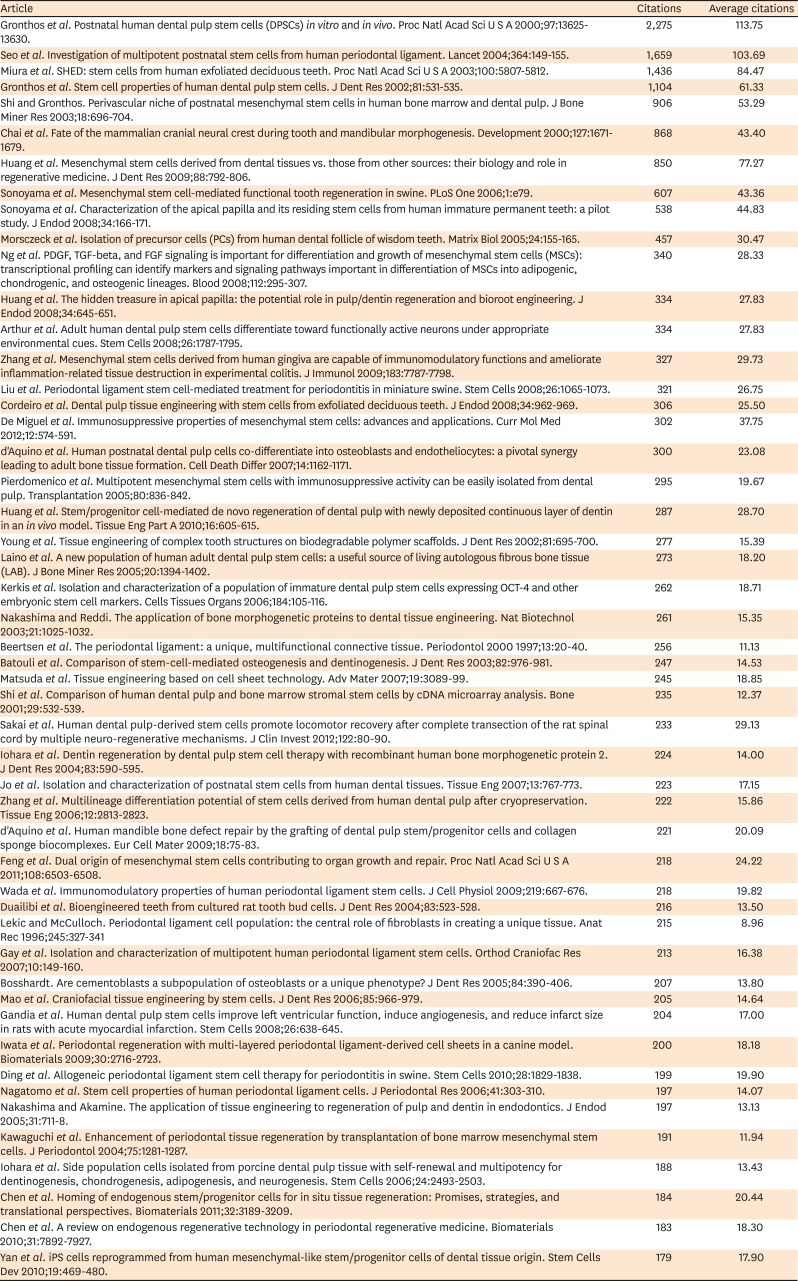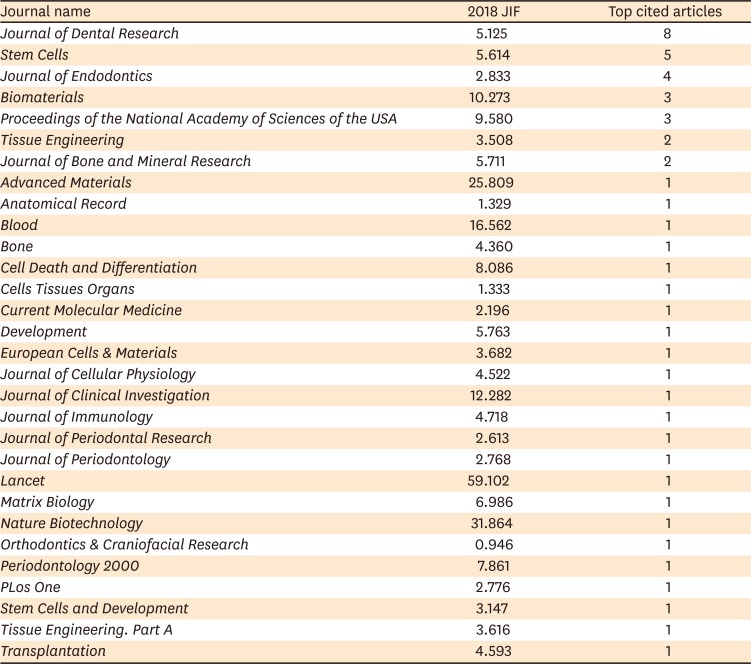INTRODUCTION
Tissue engineering in endodontology represents a scientific field that applies the basic principles of engineering and life sciences to the regeneration of oral tissues affected by trauma or infectious diseases providing possibilities for treatment plans where present conventional treatments are inadequate. More specifically, stem cell-based therapies represent a promising tool to replace damaged dental structures and restore compromised dental pulp or even tooth loss [
1].
Fifteen years have passed since Gronthos
et al. [
2], first began experiments to isolate dental pulp stem cells, and ten years since the first published report concerning stem cells from exfoliated deciduous teeth. Dental stem cell literature has been rapidly evolving over the last few decades. Several populations of post-natal stem cells have been isolated from different parts of the tooth including cells from the pulp of deciduous or permanent teeth, the periodontal ligament, the apical papilla, the dental follicle, with these tissues being studied as potential sources of cell types for regenerative tissue engineering approaches and related clinical applications [
2345678]. Tissue engineering applications represent treatment modalities that combine stem cells, molecular signals to induce cell differentiation and scaffolds as a three-dimensional environment for cell proliferation and differentiation [
1].
The bibliometric analysis includes both quantitative descriptions of research outcomes and qualitative analysis using citation analysis. Citation analysis is a feasible method to assess scientific productivity and the impact of specific research. More specifically, it examines how often an article is cited in different sources to analyze scientific production. Scientific outputs of countries, institutions, or journals in medicine such as interventional cardiology [
9], orthopedics [
10], neurocritical care research [
11], urology [
12] and in dentistry [
13], paediatric dentistry [
14], regenerative endodontics [
15] and endodontics [
16] and implantology [
17] have been evaluated using bibliometric methods.
Review articles covering this scientific field give the reader insights into the current status of stem cell literature and existing research protocols by reflecting on increasing or decreasing trends in tissue engineering research and providing future perspectives. Despite the rapid growth rate in scientific publications, there have been few attempts at gathering and evaluating data on dental stem cell research. By now, highly cited papers in dental stem cell research have not been evaluated. The present study objected to reporting on the 50 top-cited articles published in the dental stem cell field to assess the academic importance of the related publications.
Go to :

MATERIALS AND METHODS
The Science Citation Index Expanded (SCIE) from the database Clarivate Analytics Web of Science (WoS) was utilized to perform the search and analyze the highly cited articles in dental stem cell research, using predefined search terms [
18]. On 2 October 2019, we tried to identify the top-cited articles pertaining to dental stem cell research using the keywords (“stem cell*” or “mother cell*” or “progenitor cell*” or “colony forming unit*”) AND (“dental pulp*” or “apical papilla*” or “dental follicle*” or “periodontal ligament*” or “exfoliated deciduous teeth”) in the topic field. Terms used for the stem cell searches were chosen in accordance with Medical Subject Heading used to index PubMed© contents. Additionally, the search in the topic field includes terms or phrases in specific parts of the document such as title, abstract, author keywords, and Keywords Plus. The Keyword Plus in the SCIE database supplied additional search terms included in the titles of articles cited by authors in their bibliographies in the Institute for Scientific Information database and substantially augmented title-word and author-keyword indexing [
19]. No limitation was applied, apart from the “front page” filter, meaning that the keywords should be present on the front page of the papers,
e.g., title, abstract, or keywords. The papers included in the analysis were ranked in descending order according to their citation number. Two different investigators analyzed the dental stem cell papers and established the top-cited list.
Specific parameters regarding article title, total citations, citations per year, publication year, journals, journal impact factor (JIF), authors, number of authors, contributing institution and country (which was the institution and the country of the corresponding author) and keywords of each manuscript were retrieved. The authors’ department was not taken into account when all of them came from the same institution. Papers were also categorized into original research articles and review studies. Research articles were further categorized into clinical science papers, in vivo (animal research), and in vitro (laboratory) studies.
Go to :

DISCUSSION
The last few decades have seen rapid evolution and significant developments in dental stem cell research. Indeed, a large volume of articles is published almost daily. The purpose of the present study was to report and characterize the 50 top-cited articles in dental stem cell research. Even though the significance of citation analysis has been characterized as ambiguous, supporters advocate that such an analysis evaluates with objective and quantitative measures, the academic importance of an article on its respective field [
1220]. Indeed, this is one feasible method that demonstrates patterns of authorship, basic contributions, and conclusions that are guiding this scientific field. The establishment of a citation rank list allows researchers to specify the time frame on literature analysis, but also provides a comprehensive guide to education and training.
As stated by the WoS Core Collection, more than 8,850 of the world's leading scientific and technical journals across 150 scientific disciplines encompass the SCI Expanded [
18]. Justifiably this database represents the most commonly used source database for a broad review of scientific accomplishment in citation analyses.
The citations ranged from 179 to 2,275 in the top-cited articles. The rapidly evolving nature of this scientific field might explain the wide range observed in the citations number. Even though a comprehensive assessment of each individual paper separately exceeds the objectives of the present study, it remains necessary to describe the distinguishing aspects of the first highly cited studies with more than 1,400 citations each. The outcomes reported in the 3 highly cited publications have had a formative historical impact on dental stem cell research and explains why they were so widely referenced. The most cited paper with 2,275 citations and the highest average citations per year values (113.75), published by Gronthos
et al. [
2] in
Proceedings of the National Academy of Sciences of the USA, was describing for the first time the isolation of dental pulp stem cells from third molars. According to this study, postnatal DPSCs were characterized as clonogenic and highly proliferative cells, capable of generating densely calcified colonies and occasional nodules. Interestingly, the second most cited paper, published in 2004 by Seo
et al. [
8], has received 1,659 citations and described the presence of multipotent postnatal stem cells in the human periodontal ligament. When these cells were transplanted into rodents, they were able to generate a cementum/periodontal ligament-like structure and contributed to periodontal tissue repair. These cells could also be isolated from cryopreserved periodontal ligaments while still retaining their stem cell characteristics, including single-colony strain generation, expression of mesenchymal stem cell (MSC) surface markers, multipotential differentiation and hence providing a ready source of MSCs. The third paper, published in 2003 by Miura
et al. [
3], has been cited 1,436 times. This research article identified that exfoliated human deciduous teeth contain highly proliferative, clonogenic stem cells, able to induce bone formation, generate dentin, and differentiate into neural cells and adipocytes
in vivo.
The vast majority of the top-cited articles (96%) were published after 2000, which may reflect the successful isolation of stem cells from dental pulp in 2000, stimulating the study of the dental stem cells to reach new levels. More than half of the top-cited articles (27 out of 50) were published in a 4-year peak period, between 2005 and 2009. Thirty journals published the 50 top-cited articles, with the predominance of Journal of Dental Research, Stem Cells, and Journal of Endodontics. Two hundred forty-three authors from 32 institutions in 14 countries authored the 50 articles. Shi dominated with 19 publications, was leading the top-cited list and followed by Gronthos, who was the first author or co-author in 12 top-cited papers. The articles written by authors Liu and Robey were also prominent in citations.
As it was expected, most of the top-cited papers (38%) originated from the United States, a result which follows patterns from other scientific fields such as neurocritical care research, dentistry, regenerative endodontology, endodontology, implant dentistry, and dental education journals [
111315161721]. The size of the scientific community, in conjunction with the availability of funding opportunities for US-led scientific and clinical research, promotes high impact and publication output. Even though the United States was the leading country in the topmost cited publications, Asian or European residents contributed 15 and 11 articles, respectively. It should also be taken into account that 11 of the articles originating from the United States were the product of international collaborations, 6 papers resulted from multi-university collaborations, and 2 articles from independent institutions.
Scientific co-operation has been documented as an essential component in enhancing the scientific influence of research [
22]. It has been estimated that highly cited papers were produced by multinational research, while the least cited articles were the single institution papers within a single country [
22]. More than half (
n = 38) of the top-cited articles were the product of collaboration, namely 23 internationally collaborative and 15 multi-university papers. NIDCR in the USA was the home institution of the corresponding author in six out of 50 highly cited papers during the period 2000–2004.
This study also identified keywords that trended across the topmost cited publications. Among 197 unique keywords, DPSCs (
n = 12) and mesenchymal stem cell(s) (
n = 8) were the most frequently used. A keyword analysis is one of the most important indicators of bibliometrics. It can potentially detect trending research topics and provides a clear aspect of the analysis of the research hotspots. A detailed classification and analysis of a research area may be more accurate as the use of keywords retrieves more relevant results than using sentences or phrases. Representing what authors consider the essential keywords in their publication, they act as “codes” to source the relevant scientific literature. Keyword analysis can potentially detect trending research topics both currently and in the past [
23]. Regarding study limitations, lack of keyword was recorded in 13 top-cited articles in the present study.
The majority of highly cited articles were in the field of basic science (74%). It is widely accepted that basic sciences play a fundamental role in dental stem cell research. The design of new treatment strategies firstly involves laboratory studies to collect safety data, followed by further animal studies, to confirm the initial evidence about the effects of the new treatment, and finally, the application of the new knowledge to clinical studies.
There are some limitations innate to citation analyses. Besides the fact that citation analysis is an objective technique for the investigators' or scientific research recognition, it does not take into consideration self-citation or negative citation [
24] and language bias. In addition, the following methodological limitations must be kept in mind when reviewing the results of the present citation analysis: articles included in this study were identified through SCI Expanded of WoS, omitting some papers from other sources which might be considered essential to the field. The ‘obliteration by incorporation’ effect described by Garfield
et al. [
25] represents an additional bias since older publications tend to be referenced more than newer, as their results become integrated part of the evolving body of knowledge over time. Additionally, it has been documented that citation analysis omits or undervalues recently published influential papers that fail to accumulate enough citations to warrant inclusion [
26]. Notwithstanding, the shortcoming of time was not so obvious in the present analysis, as the majority of the topmost cited articles were published within the last 15 years because dental stem cell research dates back relatively few years.
Go to :




